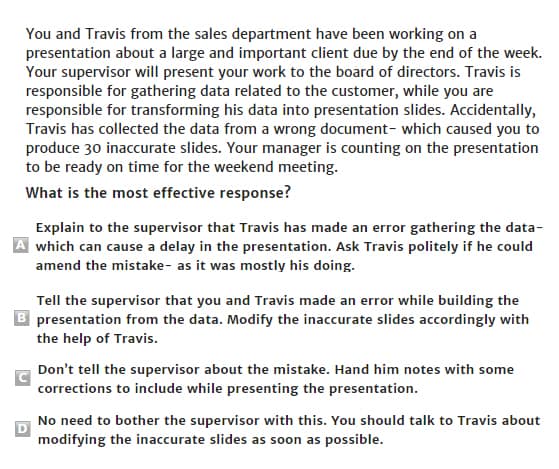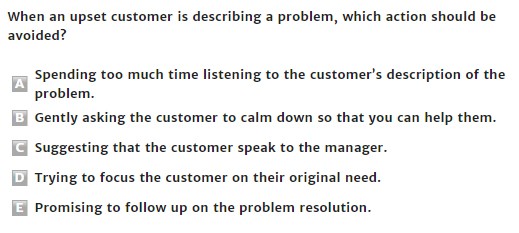Situational Judgement Test Guide 2023
Been asked to take a situational judgement test? You’re in the right place. Keep reading to learn everything you need to pass.
In this free situational judgement test guide we will show you:
- 4 simple tips to ace the situational judgement test
- Practice questions (with answers)
- How the tests are scored and what this depends on
You can find our recommended situational judgement practice tests here.
What is a situational judgement test?
Situational judgement tests (often abbreviated to SJTs) are used by employers to assess how suitable you are for a particular role.
They present a number of hypothetical situations related to the role, and ask how you would react in those situations. Your answers will tell the employer how well you fit with their expectations and company values.
SJTs are common in industries like law, finance and banking, sales and customer service, marketing, and government.
They’re also tailored to the role you’re applying for. That means these tests are all very different in terms of the content of the questions, and the answers the employer is looking for.
In general, situational judgement tests will measure a range of core skills (usually referred to as competencies) like:
- Communication
- Decision-making
- Conflict resolution
- Teamwork
- Customer focus
- Critical and creative thinking
- Planning and organising
Essentially, they’re designed to give employers an idea of how you’ll perform in that particular role and work environment.
What to expect
A situational judgement test will typically give you 25 to 50 work-related scenarios and a number of multiple-choice answers for each one.
You’ll need to choose the most appropriate solution or action for each scenario.
There are a range of ways you might need to answer the questions:
- There might be one correct answer
- You might need to choose the most effective and least effective of the possible answers, or
- You might need to rank the answers in order of most effective to least effective.
These tests are not timed.
Your responses are more important here than how quickly you give them.
So, while you should try and move through at a somewhat steady pace, you can take the time you need to think through the questions and choose the correct answers.
Situational judgement test example questions and answers
Remember:
SJTs vary greatly based on the industry, company and role you’re applying for.
With that said, you can get a feel for what to expect with some general practice questions. Take a look at a couple of situational judgement test questions (and answers) from JobTestPrep:
ANSWER
The solution to this problem is to show integrity, admit mistakes, and be willing to share responsibility as a team.
And here’s one more example question to try:
ANSWER
Here, you need to choose the least effective response.
In a situation like this, you would want to be polite and empathise with the customer while trying to solve their problem as quickly as possible.
How are situational judgement tests scored?
SJTs are usually scored right away.
The employer answers all the questions on the test beforehand, and then your answers will be automatically scored according to how they match up with the employer’s answers.
Your final score can depend on three things:
- How many of your responses match the employer’s responses
- How your score breaks down by the competencies you were assessed on, and
- How your score compares to the other candidates’ scores.
Situational judgement test video guide
Here is a video guide from BeMo Academic Consulting with some key tips, help and advice for your upcoming situational judgement test.
How to pass your situational judgement test: 4 pro tips
#1: Learn everything about the role
It’s pretty clear by now that your performance in an SJT rides on how well you know the role you’re applying for.
There are two parts to this:
- Knowing the job you’ll be doing, and
- Knowing the employer’s values.
To know the job you’ll be doing, get in touch with the employer and ask them for a copy of the full job description.
Make sure you understand what skills you’ll need in the role, and what sorts of situations you’re likely to encounter day to day.
It’s also essential to know about the employer’s values. How do they operate? What sort of culture do they have? Take the time to research the company and find out what qualities they want from their employees.
One of the best ways to approach each question on the test is to think, “How would the employer answer this question?”.
The more you understand the role and employer, the more likely you are to pass.
#2: Practice, practice, practice!
It goes without saying, but practice is key to passing any type of psychometric test — including this one.
Take as many situational judgement practice tests as you can. Even if the questions aren’t specific to your role, you’ll still benefit by getting familiar with the way the test is structured and the different question formats.
And if you’re worried about nerves?
Repeated practice is the best way to increase your confidence on the day. These are our recommended situational judgement practice tests.
#3: Use what you know
Unlike mechanical comprehension tests and other tests of knowledge, SJTs don’t require you to learn any specific rules or concepts.
They’re based only on general knowledge and your own experiences. So, don’t be afraid to draw on those life experiences when it comes to answering the test questions.
Have you been in a similar scenario to the one described? Use what you learnt from being in that situation. Your own experiences and insights are very valuable, especially in customer-facing roles.
#4: Consider all the options
This might sound obvious, but make sure you read the questions very carefully.
Consider the scenario and every possible option before you choose your answer.
Sometimes the first option will seem like the right answer straight away, but it’s important to read them all. Some questions will be designed to trip you up. They might be intentionally unclear in the way they’re phrased, or there might be two possible options that seem very similar.
So, read through the questions carefully and make sure you fully understand the scenario before coming to a conclusion.
Remember, you’re not being asked whether the options are right or wrong. You’re being asked which is the best available (or worst available) option from those provided.
And on that note:
Make sure you think carefully about what the least preferred option is, too. Often, it’s just as much about knowing what not to do in a given situation as it is about what you should do.
Some more guides to help you succeed…
- Numerical Reasoning: Numerical Reasoning Test Guide: 5 Proven Tips to Succeed
- Verbal Reasoning: Verbal Reasoning Test: What You Need to Know to Pass
- UKCAT: UKCAT Test Guide: 4 Secrets to UKCAT Success 2020
- Watson-Glaser: Watson-Glaser Test: Everything You Need to Know to Pass
- Logical Reasoning: Logical Reasoning Test: The Ultimate How-to-Pass Guide






